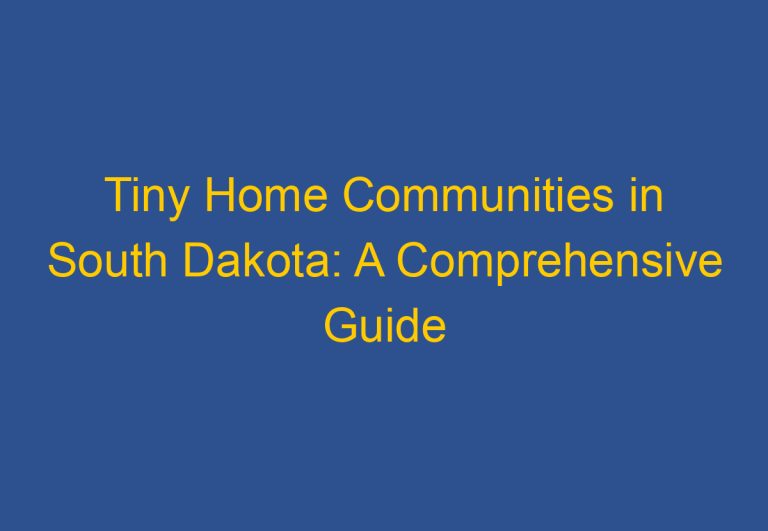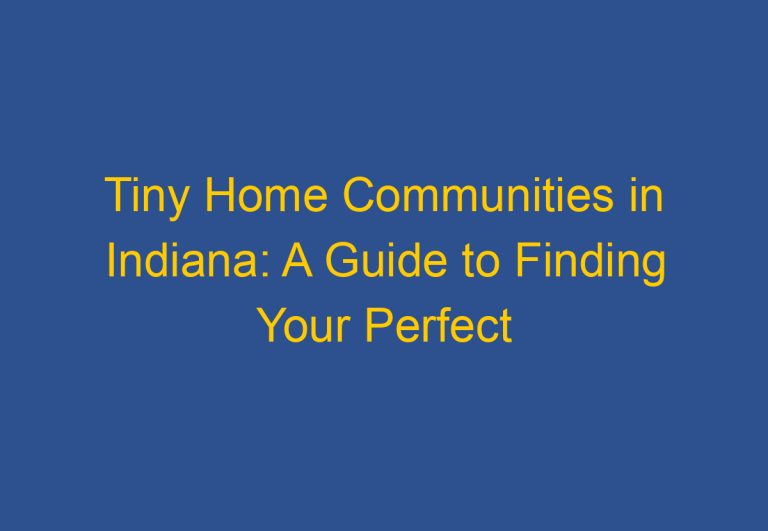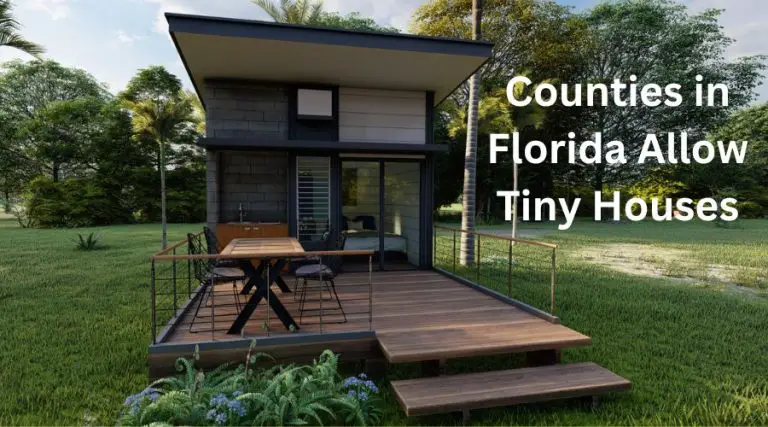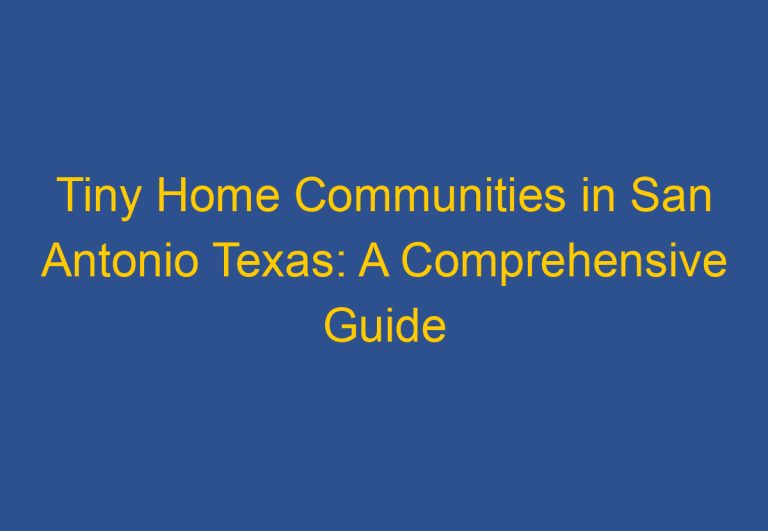Tiny Home Communities in Colorado Springs: A Comprehensive Guide
Colorado Springs is a picturesque city located in the heart of Colorado. It is known for its breathtaking mountain views, outdoor activities, and vibrant culture. Recently, tiny home communities have become a popular option for those looking to live a minimalist lifestyle in Colorado Springs. These communities offer an affordable and sustainable way of living, and they are attracting people from all walks of life.
There are currently several tiny home communities in Colorado Springs, each with its own unique features and amenities. Some of these communities are designed for permanent living, while others cater to short-term stays. For instance, Peak View Park is a tiny home community located just 25 minutes northwest of Colorado Springs. It offers both park model and tiny house on wheels for full-time living, as well as short-term rentals for anyone interested in trying out tiny living or just vacationing in the mountains.
Working Fusion at Mill Street is another popular tiny home community in Colorado Springs. It is a development by non-profit organization WeFortify, and it offers a variety of tiny home options for residents. This community is designed to combat the housing crisis in Colorado Springs and provide affordable housing for those in need. Overall, tiny home communities in Colorado Springs offer a unique and sustainable way of living that is gaining popularity among residents and visitors alike.
Benefits of Tiny Home Communities in Colorado Springs
Tiny home communities in Colorado Springs offer a range of benefits to residents, from affordability and cost savings to sustainable living and environmental impact. These communities also provide a sense of community and shared spaces for residents to enjoy.
Affordability and Cost Savings
One of the biggest benefits of tiny home communities in Colorado Springs is their affordability. Tiny homes are significantly cheaper than traditional homes, and they require less maintenance and upkeep. Additionally, tiny home communities often offer lower lot rent than traditional housing developments, which can save residents even more money.
Sustainable Living and Environmental Impact
Tiny home communities in Colorado Springs are also a great option for those who want to live a more sustainable lifestyle. These homes are typically much more energy-efficient than traditional homes, and many are equipped with solar panels or other renewable energy sources. Additionally, because tiny homes are smaller, they require fewer resources to build and maintain, which can help reduce their environmental impact.
Sense of Community and Shared Spaces
Finally, tiny home communities in Colorado Springs provide residents with a strong sense of community and shared spaces. Many of these communities offer common areas for residents to gather and socialize, such as community gardens, parks, and recreation areas. This can help foster a sense of belonging and connection among residents, which can be especially important for those who are new to the area or who are looking to build new relationships.
In conclusion, tiny home communities in Colorado Springs offer a range of benefits to residents, including affordability, sustainable living, and a strong sense of community. Whether you’re looking for a more affordable housing option or simply want to live a more sustainable lifestyle, a tiny home community in Colorado Springs may be the perfect choice for you.
Key Players and Developments
Working Fusion at Mill Street
Working Fusion at Mill Street is a tiny house community in Colorado Springs that was developed by the non-profit organization WeFortify. The community is meant to provide housing for at-risk young adults. The development has gained a lot of attention due to its unique approach to providing affordable housing to people who need it the most.
Shelley Jensen, the CEO of Working Fusion, has been instrumental in the success of the project. She has worked tirelessly to ensure that the community is a safe and welcoming place for all residents. The first two of 18 tiny homes have already been built and are ready for occupancy.
We Fortify’s Initiatives
WeFortify is a non-profit organization that is committed to providing affordable housing to people in need. The organization has been instrumental in the development of Working Fusion at Mill Street, as well as other tiny house communities in Colorado Springs.
The organization’s initiatives have helped to break the cycle of poverty and prevent homelessness in the area. WeFortify has also been instrumental in providing support services to residents of the tiny house communities, including job training and education programs.
Peak View Park and Woodland Park
Peak View Park is a park model and tiny house on wheels community for full-time living. It is located in Woodland Park, which is just 25 minutes northwest of Colorado Springs. The community is a beautiful small mountain city that offers a unique living experience for residents.
The community has gained a lot of attention due to its unique approach to providing affordable housing to people who need it the most. The development has been successful due to the hard work of the developers and the support of the local community.
In conclusion, these key players and developments have been instrumental in the success of the tiny house community movement in Colorado Springs. They have helped to provide affordable housing to people in need and have worked tirelessly to ensure that the communities are safe and welcoming places for all residents.
Challenges and Considerations
Zoning and Legal Restrictions
One of the main challenges facing tiny home communities in Colorado Springs is navigating local zoning laws and building codes. Regulations regarding accessory dwelling units (ADUs) can vary from one municipality to another, making it essential to understand local zoning laws and building codes before planning a tiny home community.
Human services organizations and other groups that want to build tiny home communities must work closely with local governments to ensure that their projects comply with zoning and building regulations. They may also need to obtain special permits or variances to build tiny homes in areas where they are not currently allowed.
Infrastructure and Accessibility
Another challenge facing tiny home communities in Colorado Springs is ensuring that residents have access to adequate infrastructure and services. This includes things like water, electricity, and sewage systems, as well as transportation and other amenities.
To address these challenges, many tiny home communities partner with local governments, utilities, and other organizations to provide infrastructure and services to residents. For example, some communities may install solar panels or other renewable energy systems to provide electricity, while others may partner with local transit agencies to provide transportation to residents.
Addressing Homelessness and Poverty
Tiny home communities in Colorado Springs also play an important role in addressing homelessness and poverty in the area. Many communities are designed to provide affordable housing to low-income residents, including those who are experiencing homelessness or at risk of becoming homeless.
To support these residents, many communities partner with human services organizations and other groups to provide job training, counseling, and other support services. They may also work with local governments and other organizations to provide healthcare, education, and other services to residents.
Overall, tiny home communities in Colorado Springs face a number of challenges and considerations, from navigating zoning and building regulations to providing infrastructure and services to residents. However, with careful planning and collaboration, these communities can serve as an important tool in addressing homelessness and poverty in the area.
Community Features and Amenities
Design and Layout of Tiny Home Villages
The design and layout of tiny home communities in Colorado Springs vary from one community to another. Some communities, such as Working Fusion at Mill Street, have a more urban feel, while others, like Mountain View Village, offer a serene mountain setting.
Most tiny home villages have a well-planned layout that maximizes space and promotes a sense of community. The homes are usually arranged in a way that creates a central common area where residents can gather, socialize, and engage in community activities.
Available Services and Facilities
Tiny home communities in Colorado Springs offer a range of services and facilities to their residents. These can include laundry facilities, community gardens, RV hookups, and even fitness centers.
Some communities may also offer rental services for tools and equipment, which can be helpful for residents who need to complete DIY projects or repairs around their homes.
Community Engagement and Activities
Community engagement and activities are an important aspect of life in tiny home villages. Most communities have a community contract that outlines the expectations for residents in terms of engagement and participation in community activities.
These activities can range from potluck dinners and barbecues to game nights and movie screenings. Some communities also have dedicated spaces for activities such as yoga, meditation, and art classes.
Children are also welcome in many tiny home communities in Colorado Springs, and some communities even have dedicated play areas for kids.
Overall, tiny home communities in Colorado Springs offer a unique and rewarding living experience for those who value simplicity, community, and sustainability.
Frequently Asked Questions
What are the top-rated tiny home communities available for purchase in Colorado Springs?
Colorado Springs is home to several top-rated tiny home communities, including Peak View Park, which is a park model and tiny house on wheels community for full-time living. Other highly-rated communities in the area include the WeeCasa Tiny House Resort and the Working Fusion at Mill Street.
Where can I find affordable tiny home living options in Colorado Springs?
Affordable tiny home living options can be found in several communities in Colorado Springs, including the Peak View Park, which offers park model and tiny house on wheels options for full-time living. Other communities with affordable options include the WeeCasa Tiny House Resort, which offers nightly rentals and longer-term leases.
Can I rent a tiny house within a community in Colorado Springs?
Yes, several tiny home communities in Colorado Springs offer rental options, including the WeeCasa Tiny House Resort, which offers nightly rentals and longer-term leases.
Which builders are recognized for constructing quality tiny homes in the Colorado Springs area?
There are several builders in the Colorado Springs area that are recognized for constructing quality tiny homes, including Tumbleweed Tiny House Company, Rocky Mountain Tiny Houses, and Sprout Tiny Homes.
What are the regulations for setting up a tiny home in El Paso County, Colorado?
El Paso County, Colorado has specific regulations for setting up a tiny home, including requirements for minimum square footage and zoning restrictions. It is recommended to consult with local zoning and building officials to ensure compliance with all regulations.
Are there specific counties in Colorado that are more accommodating to tiny home communities?
Yes, some counties in Colorado are more accommodating to tiny home communities than others. Counties such as Elbert, Park, and Teller have more lenient regulations and zoning laws for tiny homes. However, it is recommended to consult with local zoning and building officials to ensure compliance with all regulations.












